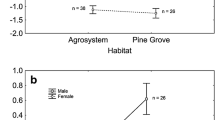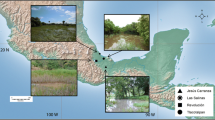Abstract
The scent marks of saddle back tamarins remained attractive to conspecifics for 1–3 days depending on the conditions under which they were tested. The monkeys discriminated between gender on the basis of fresh, one-, and two-day-old marks but not on the basis of three- and four-day-old marks.
Similar content being viewed by others
References
Altman, S.A., andWagner, S.S. 1970. Estimating rates of behavior from Hansen frequenciesPrimates 11:181–183.
Beauchamp, G.K., Wellington, J.L., Wysocki, C.J., Brand, J.G., Kubie, J.L., andSmith, A.B. III. 1980. Chemical communication in the guinea pig: Urinary components of low volatility and their access to the vomeronasal organ, pp. 327–339,in D. Müller-Schwarze and R.M. Silverstein (eds.). Chemical signals. Vertebrates and Aquatic Invertebrates. Plenum Press, New York.
Cebul, M.S., Alveario, M.C., andEpple, G. 1978. Odor recognition and attachment in infant marmosets, pp. 315–330,in H. Rothe, H.J. Wolters, and J.P. Hearn (eds.). Biology and Behaviour of Marmosets. Eigenverlag Rothe, Göttingen.
Dawson, F. 1978. Composition and stability of social groups of the tamarinSaguinus oedipus geoffroyi in Panama: Ecological and behavioral implications, pp. 23–37,in D.G. Kleiman (ed.). The Biology and Conservation of the Callitrichidae. Smithsonian Institution Press, Washington, D.C.
Epple, G. 1971. Discrimination of the odor of males and females by the marmosetSaguinus fuscicottis ssp.Proc. Int. Congr. Primatol. (Zürich, 1970). 3:166–171.
Epple, G. 1974. Olfactory communication in South American primates.Ann. N. Y. Acad. Sci. 237:261–278.
Epple, G. 1975. The behavior of marmoset monkeys (Callithricidae), pp. 195–239,in L.A. Rosenblum (ed.). Primate Behavior, Vol. 4. Academic Press, New York.
Epple, G. 1976. Chemical communication and reproductive processes in nonhuman primates, pp. 257–282,in R.L. Doty (ed.). Mammalian Olfaction, Reproductive Processes and Behavior, Academic Press, New York.
Epple, G. 1978a. Notes on the establishment and maintenance of the pair bond inSaguinus fuscicollis, pp. 231–237,in D.G. Kleiman (ed.). The Biology and Conservation of the Callitrichidae. Smithsonian Institution Press, Washington, D.C.
Epple, G. 1978b. Studies on the nature of chemical signals in scent marks and urine ofSaguinus fuscicollis (Callithricidae, primates).J. Chem. Ecol. 4:383–394.
Epple, G. 1978c. Lack of effects of castration on scent marking, displays and aggression in a South American primate (Saguinus fuscicollis).Horm. Behav. 11:139–150.
Epple, G. 1979. Gonadal control of male scent in the tamarinSaguinus fuscicollis (Callitrichidae, Primates).Chem. Senses Flavor 4:15–20.
Epple, G., andKatz, Y. 1980. Social influences on first reproductive success and related behaviors in the saddle-back tamarin (Saguinusfuscicollis, Callitrichidae). Int. J. Primatol., in press.
Epple, G., Golob, N.F., andSmith, A.B., III. 1979. Odor communication in the tamarinSaguinus fuscicollis. Behavioral and chemical studies, pp. 117–130,in F.J. Ritter (ed.). Chemical Ecology: Odour Communication in Animals. Elsevier North-Holland, Amsterdam.
Golob, N.F., Yarger, R.G., andSmith, A.B. III. 1979. Primate chemical communication, Part III: Synthesis of the major volatile constituents of the marmoset (Saguinus fuscicollis) scent mark.J. Chem. Ecol. 5:543–555.
Hershkovitz, P. 1977. Living New World Monkeys (Platyrrhini), Vol. I. University of Chicago Press, Chicago.
Izawa, K. 1978. A field study of the ecology and behavior of the black-mantle tamarin (Saguinus nigricollis)Primates 19:241–274.
Johnston, R.E., andLee, N.A. 1976. Persistence of the odor deposited by two functionally distinct scent marking behaviors of golden hamsters.Behav. Biol. 16:199–210.
Johnston, R.E., andSchmidt, T. 1979. Responses of hamsters to scent marks of different ages.Behav. Neural Biol. 26:64–75.
Kingston, B.H. 1964. The chemistry and olfactory properties of musk, civet and castoreum.Proc. 2nd Int. Congr. Endocrinol. London, pp. 209–214.
Lydell, K., andDoty, R.L. 1972. Male rat odor preferences for female urine as a function of sexual experience, urine age and urine source.Horm. Behav. 3:205–212.
Müller-Velten, H. 1966. Über den Angstgeruch bei der Hausmaus (Mus musculus L).Z. vergl. Physiol. 52:401–429.
Neyman, P.F. 1978. Aspects of the ecology and social organization of free ranging cotton-top tamarins (Saguinus oedipus) and the conservation status of the species, pp. 39–71,in D.G. Kleiman (ed.). The Biology and Conservation of the Callitrichidae. Smithsonian Institution Press, Washington, D.C.
Perkins, E.M. 1966. The skin of the black-collared tamann (Tamarinus nigricollis).Am. J. Phys. Anthropol. 25:41–69.
Regnier, F.E., andGoodwin, M. 1977. On the chemical and environmental modulation of pheromone release from vertebrate scent marks, pp. 115–133,in D. Müller-Schwarze and M.M. Mozell (eds.). Chemical Signals in Vertebrates, Plenum Press, New York.
Siegel, S. 1956. Nonparametric Statistics for the Behavioral Sciences. McGraw-Hill, New York.
Smith, A.B., III, Yarger, R.G., andEpple, G. 1976. The major volatile constituents of the marmoset (Saguinus fuscicottis) scent mark.Tetrahedron Lett. 1976:983–986.
Thiessen, D.D. 1976. The Evolution and Chemistry of Aggression. Charles C. Thomas, Springfield, Illinois.
Thorington, R.W., Jr. 1968. Observations of the tamarinSaguinus midas, Folia Primatol. 9:95–98.
Wellington, J.L.,Beauchamp, G.K., andSmith, A.B. III. 1980. Stability of urine based chemical communication in guinea pigs. In preparation.
Yarger, R.G., Smith, A.B., III, Preti, G., andEpple, G. 1977. The major volatile constituents of the scent mark of a South American primateSaguinus fuscicollis Callithricidae.J. Chem. Ecol. 3:45–56.
Author information
Authors and Affiliations
Additional information
NIH Research Career Development Award, 1973–1978.
Camille and Henry Dreyfus Teacher Scholar, 1978–1983. NIH Research Career Development Award, 1980–1985.
Rights and permissions
About this article
Cite this article
Epple, G., Catherine Alveario, M., Golob, N.F. et al. Stability and attractiveness related to age of scent marks of saddle back tamarins (Saguinus fuscicollis). J Chem Ecol 6, 735–748 (1980). https://doi.org/10.1007/BF00990398
Received:
Revised:
Issue Date:
DOI: https://doi.org/10.1007/BF00990398




